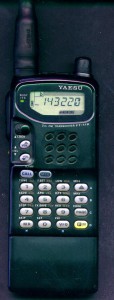This is a review of the newest radio in my collection, the Wouxun KG-UV3D. This radio is sold exclusively by Powerwerx in the US. I purchased this radio as both an Amateur HT and for business use.
Overall: At first glance, this handheld looks like any other dual-bander amateur HT. It has a two-line display for showing frequencies in the A and B banks. It has backlit keys, and a red “MENU” button in contrast to the black keypad. The top has two knobs, one as a rotary encoder dial for selection and one for volume/power. Pretty standard when compared to my Yaesu FT-60R.
Audio: Initial reports have been of good audio quality. The speaker is exceptionally loud. Not a bad thing for a handheld. I can have the volume near halfway and that is plenty loud for indoor use. I will be testing it with a clip mic and be using it in a loud environment later on.
Battery Life: Not sure yet. It is powered by a 1700 mAh Li-Ion battery. I don’t know if this is a good thing or not. I’m used to the NiMH and NiCd batteries found on my FT-60R and business-class Kenwood. The initial charge on the battery allowed for a cumulative 45 seconds on high power, which was nice. The rapid charger apparently filled the battery intelligently, as after 10 minutes in the charger it reports full. We’ll see how full “full” really is.
Programming: Just get the programming cable! The software is free from Wouxun/Powerwerx site. I tried doing some minor changes on the menu system, and it clearly was overly complicated. Everything I’ve read online said to just bite the bullet and get the cable and software. I’m glad I did! I was able to get the radio out, plug the cable in, and after some “unlocking” (which I’ll talk about below) it took the programming just fine. The software is a bit clunky, but it does work.
Band Coverage: This guy is best for transmitting, not necessarily for scanning. The scanner is slow, and the band coverage is really just VHF/UHF. There’s no 800 MHz listening, or in-between bands like with the FT-60R. As far as TX, you can obtain software to legally open this guy up to other bands, obviously if you are licensed to transmit in those bands/frequencies. I am covered under a license for a business band UHF frequency, and unlocked my radio to transmit on this frequency. So far it has had good signal and audio reports.
Now, the cons:
- 128 Channels – kind of small compared to other HTs with 500 or 1000
- Programming software, as I said, is clunky. Very clunky.
- Don’t yet know how smart the charger is. Seems to check the battery level before charging.
- No external DC jack – charger only
I will be adding on to this review as I own the radio. This is just a nice starting point.
[pe2-gallery album=”aHR0cDovL3BpY2FzYXdlYi5nb29nbGUuY29tL2RhdGEvZmVlZC9iYXNlL3VzZXIvbHVyY2g4OS9hbGJ1bWlkLzU1NjQ3OTE5MDQzNjA4OTY5OTM/YWx0PXJzcyZhbXA7aGw9ZW5fVVMma2luZD1waG90bw==”]


